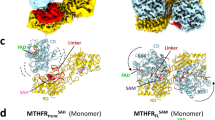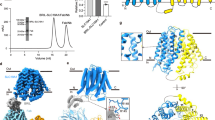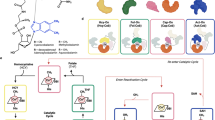Abstract
Elevated plasma homocysteine levels are associated with increased risk for cardiovascular disease and neural tube defects in humans. Folate treatment decreases homocysteine levels and dramatically reduces the incidence of neural tube defects. The flavoprotein methylenetetrahydrofolate reductase (MTHFR) is a likely target for these actions of folate. The most common genetic cause of mildly elevated plasma homocysteine in humans is the MTHFR polymorphism A222V (base change C677→T). The X-ray analysis of E. coli MTHFR, reported here, provides a model for the catalytic domain that is shared by all MTHFRs. This domain is a β8α8 barrel that binds FAD in a novel fashion. Ala 177, corresponding to Ala 222 in human MTHFR, is near the bottom of the barrel and distant from the FAD. The mutation A177V does not affect Km or kcat but instead increases the propensity for bacterial MTHFR to lose its essential flavin cofactor. Folate derivatives protect wild-type and mutant E. coli enzymes against flavin loss, and protect human MTHFR and the A222V mutant against thermal inactivation, suggesting a mechanism by which folate treatment reduces homocysteine levels.
This is a preview of subscription content, access via your institution
Access options
Subscribe to this journal
Receive 12 print issues and online access
$189.00 per year
only $15.75 per issue
Buy this article
- Purchase on Springer Link
- Instant access to full article PDF
Prices may be subject to local taxes which are calculated during checkout







Similar content being viewed by others
Accession codes
References
Frosst, P. et al. A candidate genetic risk factor for vascular disease: a common mutation in methylenetetrahydrofolate reductase. Nature Genet. 10, 111–113 ( 1995).
Kluijtmans, L.A. et al. Molecular genetic analysis in mild hyperhomocysteinemia: a common mutation in the methylenetetrahydrofolate reductase gene is a genetic risk factor for cardiovascular disease. Am. J. Hum. Genet. 58, 35–41 (1996).
Morita, H. et al. Genetic polymorphism of 5,10-methylenetetrahydrofolate reductase (MTHFR) as a risk factor for coronary artery disease. Circulation 95, 2032–2036 ( 1997).
Wilcken, D.E., Wang, X.L., Sim, A.S. & McCredie, R.M. Distribution in healthy and coronary populations of the methylenetetrahydrofolate reductase (MTHFR) C677T mutation. Arteroscler. Thromb. Vasc. Biol. 16, 878–882 (1996).
Ma, J. et al. Methylenetetrahydrofolate reductase polymorphism, plasma folate, homocysteine, and risk of myocardial infarction in US physicians. Circulation 94, 2410–2416 (1996).
Jacques, P.F. et al. Relation between folate status, a common mutation in methylenetetrahydrofolate reductase, and plasma homocysteine concentrations. Circulation 93, 7–9 (1996 ).
Harmon, D.L. et al. The common "thermolabile" variant of methylenetetrahydrofolate reductase is a major determinant of mild hyperhomocysteinaemia. Q. J. Med. 89, 515–577 ( 1996).
van der Put, N. et al. Mutated methylenetetrahydrofolate reductase as a risk factor for spina bifida. Lancet 346, 1070– 1071 (1995).
Refsum, H., Ueland, P.M., Nygard, O. & Vollset, S. Homocysteine and cardiovascular disease. Annu. Rev. Med. 49, 31–62 (1998).
van der Put, N.M.J., Eskes, T.K.A.B. & Blom, H.J. Is the common 677C→T mutation in the methylenetetrahydrofolate reductase gene a risk factor for neural tube defects? A meta-analysis. Q. J. Med. 90, 111–115 ( 1997).
Boushey, C.J., Beresford, S.A.A., Omenn, G.S. & Motulsky, A.G. A quantitative assessment of plasma homocysteine as a risk factor for vascular disease. JAMA 274, 1049– 1057 (1995).
Vitamin Study Research Group, M.R.C. Prevention of neural-tube defects. Lancet 338, 131– 137 (1991).
Goyette, P. et al. Human methylenetetrahydrofolate reductase: isolation of cDNA, mapping and mutation identification. Nature Genet. 7, 195–200 (1994).
Sander, C. & Schneider, R. Database of homology-derived protein structures and the structural meaning of sequence alignment. Proteins 9, 56–68 (1991 ).
Goyette, P., Christensen, B., Rosenblatt, D.S. & Rozen, R. Severe and mild mutations in cis for the methylenetetrahydofolate reductase (MTHFR) gene, and description of five novel mutations in MTHFR. Am. J. Hum. Genet. 59, 1268–1275 (1996).
Goyette, P., Frosst, P., Rosenblatt, D.S. & Rozen, R. Seven novel mutations in the methylenetetrahydrofolate reductase gene and genotype/phenotype correlations in severe methylenetetrahydrofolate reductase deficiency. Am. J. Hum. Genet. 56, 1052– 1059 (1995).
Lindqvist, Y. Refined structure of spinach glycolate oxidase at 2 Å resolution. J. Mol. Biol. 209, 151–166 (1989).
Xia, Z.X. & Mathews, F.S. Molecular structure of flavocytochrome b2 at 2.4 Å resolution. J. Mol. Biol. 212, 837–863 (1990).
Fox, K.M. & Karplus, P.A. Old yellow enzyme at 2 Å resolution: overall structure, ligand binding, and comparison with related flavoproteins. Structure 2, 1089– 1105 (1994).
Lim, L.W. Three-dimensional structure of the iron-sulfur flavoprotein trimethylamine dehydrogenase at 2.4 Å resolution. J. Biol. Chem. 261, 15140–15146 (1986).
Rowland, P., Nielsen, F.S., Jensen, K.F. & Larsen, S. The crystal structure of the flavin containing enzyme dihydroorotate dehydrogenase A from Lactococcus lactis. Structure 5, 239–252 (1997).
Sumner, J.S. & Matthews, R.G. Stereochemistry and mechanism of hydrogen transfer between NADPH and methylenetetrahydrofolate in the reaction catalyzed by methylenetetrahydrofolate reductase from pig liver. J. Am. Chem. Soc. 114, 6949–6956 (1992).
Eggink, G., Engel, H., Vriend, G., Terpstra, P. & Witholt, B. Rubredoxin reductase of Pseudomonas oleovorans. Structural relationship to other flavoprotein oxidoreductases based on one NAD and two FAD fingerprints. J. Mol. Biol. 212, 135–142 (1990).
Sheppard, C.A., Trimmer, E.E. & Matthews, R.G. Purification and properties of NADH-dependent 5,10-methylenetetrahydrofolate reductase from Escherichia coli. J. Bacteriol. 181, 718–725 (1999).
Kang, S.-S. et al. Thermolabile methylenetetrahydrofolate reductase: an inherited risk factor for coronary artery disease. Am. J. Hum. Genet. 48, 536–545 (1991).
Li, W.-T. et al. Thermodynamic stability of arachaeal histones. Biochemistry 37, 10563–10572 ( 1998).
Matthews, R.G. & Baugh, C.M. Interactions of pig liver methylenetetrahydrofolate reductase with methylenetetrahydropteroylpolyglutamate substrates and with dihydropteroylpolyglutamate inhibitors. Biochemistry 19, 2040–2045 ( 1980).
Jones, S. & Thornton, J.M. Protein–protein interactions: a review of protein dimer structures. Prog. Biophys. Mol. Biol. 63, 31–65 ( 1995).
Lijnzaad, P. & Argos, P. Hydrophobic patches on protein subunit interfaces: characteristics and prediction. Proteins 28, 333–343 (1997).
Blount, B.C. et al. Folate deficiency causes uracil misincorporation into human DNA and chromosome breakage: implications for cancer and neuronal damage. Proc. Natl. Acad. Sci. USA 94, 3290– 3295 (1997).
Deloughery, T.G. et al. Common mutation in methylenetetrahydrofolate reductase. Correlation with homocysteine metabolism and late-onset vascular disease. Circulation 94, 3074–3078 (1996).
Hendrickson, W.A. & Ogata, C.M. Phase determination from multiwavelength anomalous diffraction experiments. Methods Enzymol 276, 494–522 ( 1997).
The CCP4 suite: programs for protein crystallography. Acta Crystallogr. D 50, 760– 763 (1994).
Jones, T.A. & Kjeldgaard, M. O—The manual, (Uppsala University, Uppsala; 1993).
Brünger, A.T. X-PLOR: a system for X-ray crystallography and NMR (Yale University Press, New Haven, CT; 1992).
Jiang, J.S. & Brünger, A.T. Protein hydration observed by X-ray diffraction. Solvation properties of penicillopepsin and neuraminidase crystal structures. J. Mol. Biol. 264, 100 –115 (1994).
Carson, M. Ribbons. Methods Enzymol. 277, 493– 504 (1997).
Rosenblatt, D.S. & Erbe, R.W. Methylenetetrahydrofolate reductase in cultured human cells. I. Growth and metabolic studies. Pediatr. Res. 11, 1137–1141 (1977).
Acknowledgements
We thank J. Shih (Lilly Corporation) for the gift of the pentaglutamate form of 5,10-dideazatetrahydrofolate. We are indebted to C. Johnson (Calorimetry Sciences), for performing the differential-scanning calorimetry experiments shown in Fig. 4. We also thank A. Gafni for allowing us to use his fluorimeter and D. Ballou and V. Massey for assistance with the stopped-flow experiments. This work was supported by National Institute of General Medical Sciences grants to R.M and M.L., by NIH postdoctoral (B.G.) and predoctoral (C.S.) fellowships, by an NIH Cellular & Molecular Biology Training Grant (C.S.), and the Medical Research Council of Canada (R.R.) and by the McGill University Mary Louise Taylor predoctoral fellowship (P.T.).
Author information
Authors and Affiliations
Corresponding authors
Rights and permissions
About this article
Cite this article
Guenther, B., Sheppard, C., Tran, P. et al. The structure and properties of methylenetetrahydrofolate reductase from Escherichia coli suggest how folate ameliorates human hyperhomocysteinemia . Nat Struct Mol Biol 6, 359–365 (1999). https://doi.org/10.1038/7594
Received:
Accepted:
Issue Date:
DOI: https://doi.org/10.1038/7594
This article is cited by
-
Maternal nutrition and effects on offspring vascular function
Pflügers Archiv - European Journal of Physiology (2023)
-
Propionate metabolism in a human pathogenic fungus: proteomic and biochemical analyses
IMA Fungus (2020)
-
No evidence for association of MTHFR 677C>T and 1298A>C variants with placental DNA methylation
Clinical Epigenetics (2018)
-
Methylenetetrahydrofolate reductase and psychiatric diseases
Translational Psychiatry (2018)
-
Proline dehydrogenase from Thermus thermophilus does not discriminate between FAD and FMN as cofactor
Scientific Reports (2017)



